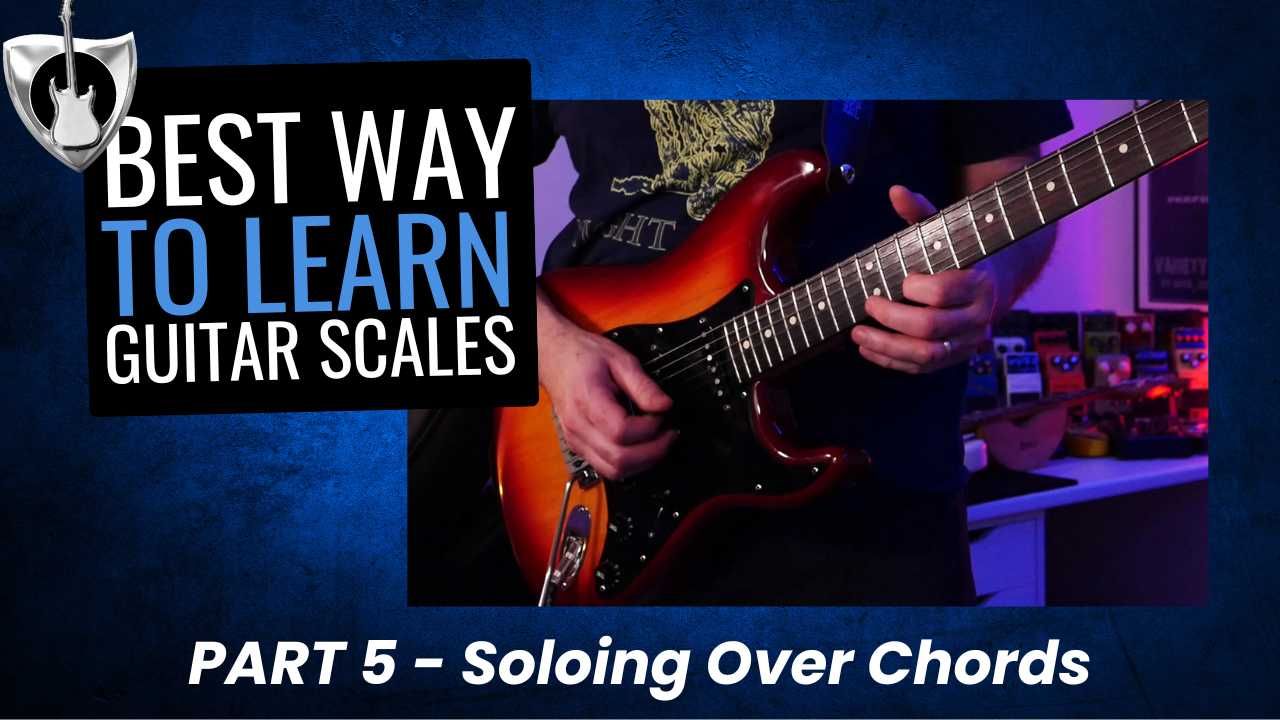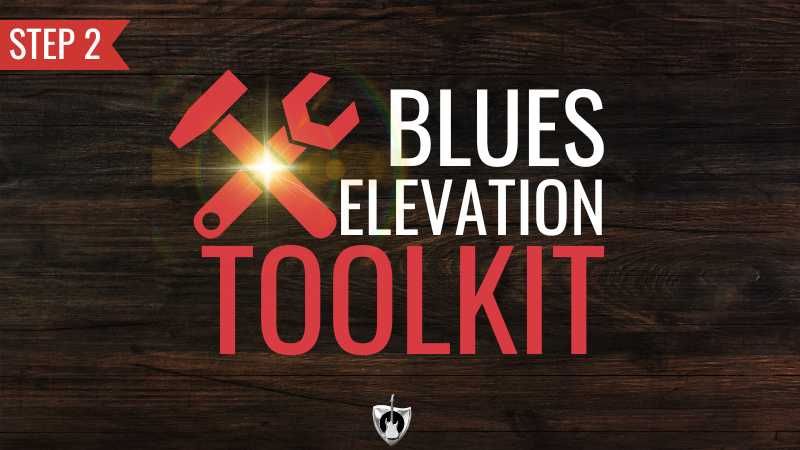Soloing Over Chords

One of the great joys of playing guitar, to me, is improvisation.
Creating new and unique melodies on the guitar can be addictive. Once you get to the point in your guitar journey where playing lead guitar becomes a priority, you are faced with a whole new set of obstacles.
Most new players that are interested in lead guitar start by memorizing the tablature of their favorite lead guitar parts.
That is fun for a while. You get up and running fast. All of the notes sound great and match the chords of the song perfectly!
What’s not to love! After getting a good group of leads memorized, most new lead players are ready to take the next step: Improvisation.
This is the point where things start getting really tough. You may start asking yourself questions like this:
- “What notes do I play?”
- “Scales huh, what’s a scale? Ok, I’ve learned a scale. It sounds nothing like my favorite songs.”
- “Are these notes right? A lot of the notes I’m playing just sound wrong.”
The more you try to play, the more you struggle. Eventually, you finally ask yourself this question:
“How do my favorite guitar players come up with this stuff?”
Wait! That’s it!
That’s the million dollar question!
How does playing scales over chords work?
Once you understand the HOW and WHY of playing lead guitar melodies, you will be on the fast track to guitar success.
This post is part of a larger series of articles that deal with “the best way to learn guitar scales. Here are the “Six essential steps you need to really understand how to use guitar scales“:
- How the fretboard is set up
- What Scales Are and How They're Built
- Best Scales for Popular Music
- The Five Pattern System
- Soloing Over Chords
- Playing Scales in Different Keys
We have made it all of the way to step five: Start playing those patterns over chords. This one step is so very important. Anyone can memorize a bunch of scale patterns, but using them and making them sound great is a whole different story.
If you haven’t learned steps one through four, I suggest you look back now before we move forward. Click here to start:
https://www.playguitaracademy.com/blog/the-best-way-to-learn-guitar-scales
Learning the guitar is like building a house.
You need a strong foundation and you need to build from the bottom up. If you are missing any of this foundational information, playing over chords will quickly feel very complicated.
Just take a quick look over the past steps and you will be ready to take on “playing scales over chords”.
Today you will learn the different ways of playing lead parts over chords and the essential steps to take to match your scales to different songs!
When to start learning to play scales over chords
In my small group classes, right after I introduce the minor pentatonic scale, I get them started right away with improvising.
The first thing I teach them is which note is the strong note (tonic) of the scale. We slide that pattern up until the tonic note is the same as the strong note (root) of the chord. At that point, the scale pattern is ready to play over the chord.
I loop a chord and then I say:
“You can play anything you want at all with the scale. You can skip notes, repeat notes, go up the scale, go down the scale. It doesn’t matter, get creative with it. Play one note one hundred times.
But when your are finished saying what you want to say, hit the tonic note. Just like you were putting a period or exclamation point at the end of a sentence.”
Try this out yourself. It’s really fun! Go ahead and loop a A7 chord , or find an A7 backing track. Then slide the A minor pentatonic pattern 1 to the fifth fret.
That puts the root of the chord and the tonic of the scales on the same note. Start improvising!
Here is a good A7 background track to use:
https://www.youtube.com/watch?v=tsy0P-BNss0
 After everyone plays this for the first time, you wouldn’t believe the smiles that start popping up around the room. The scale matched the chord. All of the notes sounded great and when they hit the tonic note at the end of their improv, their melody line felt like a completed sentence. The musical statement was over and they were ready to create the next one.
After everyone plays this for the first time, you wouldn’t believe the smiles that start popping up around the room. The scale matched the chord. All of the notes sounded great and when they hit the tonic note at the end of their improv, their melody line felt like a completed sentence. The musical statement was over and they were ready to create the next one.
You wouldn’t believe how effective and fun this is.
This is just how I get my students started. To go farther down the road, we have to have a plan.
It is not often that you only have to play a scale over one chord for a whole song.
With more complicated chord progressions and even key changes, moving forward from here can be difficult. So lets find out the different situations you may find yourself in, and the ways to approach playing over different chords.
Once you start improvising over many different songs, you will find that it’s not “one size fits all” It’s not always as easy as we did above. There are several different scenarios that you will find yourself in.
Here is what you can expect:
- One chord being played over an extended period of time. Easy once you find the right scale
- A group of different chords (chord progression) that require only one scale. Once you find the scale that matches, it sounds great over all of the chords. A blues progression is a great example of a chord progressions that you only have to play one scale over.
- A Chord progression that mostly works for one scale but has one or two chords that don’t sound right.
- A Chord progression that uses multiple scales through multiple keys.
So, now that we know what we are up against, lets create a plan for using scales in all of these situations.
Situation one: Playing over a single chord
In modern music, you may find yourself in this situation a lot. It could be a funk song, rock song, modal blues solo passage, even part of a folk or country song.
No matter what style of music you are playing, you have the same problem: How to come up with a solo over one chord.
First we need to select a scale that will match the chord we are playing over. For that we need to look at the chord we are playing.
Is it some type of Major, minor or dominant 7th chord? In this article we are going to stick with the “Big Four” scales that we went through in last weeks post.
They are:
- Major
- minor
- Major pentatonic
- minor pentatonic
For a Major type chord play either the:
- Major scale, or
- Major pentatonic scale
For a minor type chord play either the:
- Minor scale, or
- Minor pentatonic scale
If you are playing a over a dominant 7th chord you can play either the:
- Major pentatonic, or
- Minor pentatonic scale
**You can also play the “Mixolydian mode” over a dominant 7th chord. This is a pretty complicated title for a really easy scale.
The easiest way to make this scale is to take the major scale and lower the seventh note by one fret (half step). ( in the key of C the seventh note would be a B. You would lower that note one step to Bb. Now your C mixolydian would have the notes C D E F G A Bb C. That would fit perfectly over a C7 chord.)**
Once you figure out what scale to play, you just have to match it to the chord. On guitar this is easy. Just find the tonic note of the scale
pattern you are playing (it is usually highlighted) and slide the pattern up the guitar until that note is the same of the root of the chord.
Situation two: A chord progression that only requires one scale
I find this to be the most common situation my students deal with.
This where you have to play over a group of different chords, but the
chords are all related in a way that one scale works for all of them.
Playing over these are a lot of fun and super easy! You just find the key and play the appropriate scale, and it just works!
Usually these are called Diatonic Chord Progressions. What that means is that all of the chords are created from notes in the Key.
The notes in the key of C are:
C D E F G A B C
1 2 3 4 5 6 7
So lets look at an easy Diatonic chord progression in the key of C Major.
Lets play:
C / / / | F / / / | G / / / | C / / / |
Another way of writing this chord progression is:
I(1) / / / | IV(4) / / / | V(5) / / / | I(1) / / / |
( the roman numeral I means the C chord Is built from the 1st note of the scale, The roman numeral IV means that the F chord is built
from the 4th note of the scale, and the roman numeral V means that the G chord is built from the 5th note of the scale.)
The three notes in a C chord are C E and G.
The notes in a F chord are F A C.
And, the notes in a G chord are G B D.
If you check the C scale above, it contains all the notes of all the chords. These chords are related to the C major scale and sound great
with it.
Another type of chord progression that you can use one scale to play over is a blues. Try the minor pentatonic or the major pentatonic
that matches the key of a blues progression over the chords for some fun playing!
Situation 3: The chord progression that almost works for one scale.
This has happened to me so many times.
I’m playing a song that I thought would be easy. I’ve matched my scale to the chord progression.
Everything is going great and then it happens:
Klunk
One of the chords from the song doesn’t match the scale I’m using.
Ouch…
Those were serious wrong notes in the middle of a great sounding solo.
When I first started playing lead and this happened, I would just panic. The next time that chord came around, I either:
- wouldn’t play or
- I would just play the root note from the chord in my solo.
Those are both good quick fixes in a pinch. But, taking the time to really understand what to do when you have one of these “outside”
chords is worth it in the end.
Now, I love it when I run into one of these difficult chords. I think of it now as a featured chord. It’s something I can call attention to and try
new sounds over.
You have to temporarily change your scale for just this chord.
The easiest thing to do is play the arpeggio (chord notes) of that chord. That way you are guaranteed not to play a wrong note.
But, try changing the scale altogether.
Say you are playing in the key of D and you need to play over a C chord. Well that C chord is common in a lot of songs in the key of D
major, but it is not made from the D scale. Lets look at a D scale:
D E F# G A B C# D
The notes of a C chord are C E G. The C from the C chord doesn’t match the C# from the scale.
IF your chord progression was:
D / / / | A / / / | C / / / | G / / / |
I would play the D major scale Over the D, and A chords. But over the C and G, I would lower the C# of the D major scale a half step. That
change creates a new scale. It temporarily puts you in the key of G major. And that matches both the C and G chord as well.
Situation 4: Chord progression that has multiple keys:
Although most popular music generally stays in one key for the whole song, that is not the case for all music.
Especially in Jazz music.
It isvery common for one piece of music in Jazz to modulate to several different keys. To be a confident Jazz guitar improviser, you must be
extremely comfortable with changing scale patterns quickly.
Essentially, you follow the same procedure as in situation 3. You analyze the chord progressions ahead of time and see where the chord
changes go into new keys and make the appropriate changes to your scale patterns.
The simplest song to demonstrate this is “Blue Bossa”.
The majority of this song is in the key of C minor. Using the chords Cm7, Fm7, Dm7b5, G7alt, and back to Cm7.
But in the middle section there is a modulation to the key of Db Major, using the chords Ebm7, Ab7 and Dbmaj7.
After that it modulates back to the key of C minor, using the Dm7b5, G7alt, and back to Cm7.
The C minor scale pattern works over the whole first section. Then the Db Major scale patterns fits the middle section, and at the end you
transition back to your C minor scale patterns.
As you can see, even in a relatively easy song as this, shifting from one scale pattern, into a new key and then back again would take a lot
of practice and patience to do well.
Conclusion
Learning to play scales over chords is one of the most enjoyable things you can do with the guitar.
Learning to improvise with the scale patterns we have learned, takes time and is well worth it!
We talked a bit about how to start improvising over a chord progression.
We also went through the four types of chord progressions that you will be dealing with, in order from easiest to most difficult.
Playing scales over chords gets easier the more time you spend with it.
If you are new to this idea, start matching your “big four” scales to background tracks and have some fun.
If you incorporate this in your daily practice routine, you will find it wont take long before you are improvising awesome melodies with the guitar!
Question
What has been your experience with soloing over chord progressions? Let me know in the show notes below!
GET FREE WEEKLY GUITAR LESSONS, PODCASTS, AND MOTIVATION DELIVERED TO YOUR INBOX.
Your information is kept safe. It's never shared with third parties.





